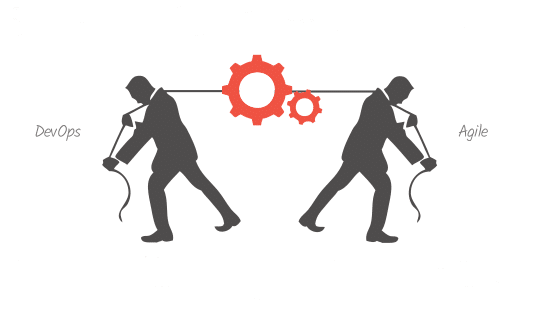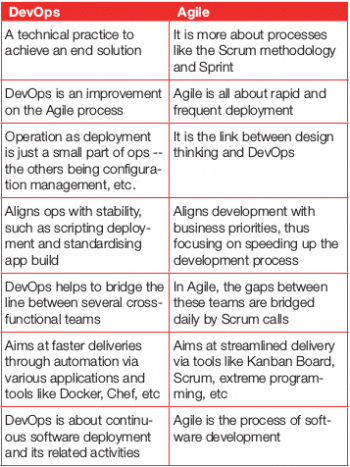Both the DevOps and Agile approaches are good for software development. Though both focus on different aspects of software development, each complements the other to produce robust, reliable, efficient and quality software in the shortest possible timeframe. This article goes into the differences between DevOps and Agile, and how beneficial it is when both work in tandem.
Development teams have been adopting Agile for the past ten years, as it has proved to be a very competent method of developing quality software. The Agile model has improved the user experience by frequently addressing focused goals and ensuring quick delivery. In addition, the broad use of DevOps in Agile methodology has made it a more compelling approach for IT organisations.
While many organisations are keen to employ these practices, there is often some uncertainty about the two. Some think that Agile is like Scrum and DevOps is a continuous delivery tool. But remember, Agile is not DevOps, and vice versa. It is hard to achieve success in DevOps, if Agile practices are not followed. And while Agile can make sense independent of DevOps, it can be more complete when accompanied by DevOps practices. Agile and DevOps are two software development methodologies with similar aims, i.e., getting the end product out as quickly and as efficiently as possible.
What is DevOps?
DevOps is the process of incorporating a particular culture and set of practices to achieve faster delivery, quicker automation, more agility, improved security and be able to serve better. It makes for a smooth flow between the IT operations team and the development team to deploy code quicker, automate tests and deliver results, which is a continuous process.
What is Agile?
The Agile methodology is a software development methodology that came to light in 2001, when the Agile manifesto was introduced. Agile encourages acceptance and a leadership mindset that promotes teamwork, self-organisation, and accountability. More essentially, the Agile approach focuses more on continuously aligning development with customer requirements and trends — even when those requirements and trends change late in the development process.
Further comparisons between Agile and DevOps
Agility
DevOps: Agility in both development and operations
Agile: Agility only in development
Process or practice?
Devops: Involves processes such as CI, CD, CT, etc.
Agile: Involves practices such as Agile Scrum, Agile Kanban, etc.
Key focus area
DevOps: Timeliness and quality have equal priority
Agile: Timeliness is the main priority
Release cycles/development sprints
DevOps: Smaller release cycles with immediate feedback
Agile: Smaller release cycles
Source of feedback
DevOps: Feedback is from self (monitoring tool)
Agile: Feedback is from the customer
Scope of work
DevOps: This mainly focuses on achieving automation by orchestrating various DevOps tools
Agile: Speed or agility only
Why is DevOps gaining immense popularity?
DevOps is a broadly acknowledged IT practice across organisations, among development and IT operations professionals. It focuses on the idea of better communication between teams and departments for better teamwork.
Why is DevOps better than Agile?
Let’s consider the challenges with Agile software development. Agile software development is a set of best practices for creating quality software in a timely manner. But the problem is, the best practices that are followed involve people working in silos — people working as developers, as testers, or as IT ops with very little communication between them. So they are not aware what those in other teams are working on, despite being a part of the same process.
This working of teams in silos is the reason for the blame game that goes on when software fails or has major flaws. When a client has complaints about software, the development team points fingers at the QA team, which will then point fingers at the IT ops team, which will redirect the blame to the dev team.
The solution to this problem is DevOps
In DevOps, the dev team, the IT ops team and the QA teams do not independently work at pieces of the project, but work as one, collaboratively.
The DevOps engineers do everything — develop code, test it and deploy it in production. This solves many problems as they are the sole owners of the project and have full ownership of the process.
What makes DevOps efficient is:
- Continuous business planning
- Collaborative development
- Continuous testing
- Continuous releases and development
- Continuous user feedback and optimisation
- Continuous monitoring
Can Agile and DevOps work together?
Agile and DevOps may have different goals to achieve, but they can be implemented together for a successful project. Will Kinard, MD, BoxBoat, mentions that it “uses the Agile methodology as a motivator for developing a DevOps culture.” As far as he’s concerned, when it comes to developing software faster and maintaining software more efficiently, both have a big role to play. “The two terms are certainly different; Agile focuses on an iterative approach to development, and DevOps brings two traditionally separate practices together — development and operations, which are normally isolated. But the ultimate goal of each one is to create further collaboration,” Kinard continues. “So, while Agile and DevOps each refer to two different things, use one to enable the other,” he concludes.
DevOps does not replace Agile; however the two complement each other very well. Agile and DevOps seek to deliver value to the end user in a more well organised way — but from different perspectives. Agile focuses on making developers and the development cycles more competent, while DevOps brings the operations team into play to allow continuous integration and continuous releases.





